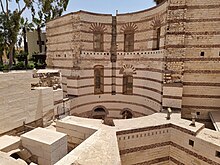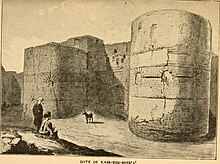Babylon Fortress
ⲡⲁⲃⲓⲗⲱⲛ | |
 Remains of one of the two towers guarding the Roman canal | |
| Alternative name | ⲡⲁⲃⲓⲗⲱⲛ |
|---|---|
| Location | Cairo Governorate,Egypt |
| Region | Lower Egypt |
| Coordinates | 30°0′22″N31°13′47″E/ 30.00611°N 31.22972°E |
30°0′22″N31°13′47″E/ 30.00611°N 31.22972°E
Babylon Fortress(Arabic:حصن بابليون;Coptic:ⲡⲁⲃⲓⲗⲱⲛ or Ⲃⲁⲃⲩⲗⲱⲛ)[1][better source needed]is anAncient Romanfortress on the eastern bank of theNile Delta,located in the area known today asOld CairoorCoptic Cairo.The fortress was built circa 300 AD by EmperorDiocletianin order to protect the entrance to anancient canal,previously rebuilt byTrajan,that linked the Nile with theRed Sea.
It was at the boundary betweenLowerandMiddle Egypt,where the river craft paid tolls when ascending or descending the Nile. Within the fortress's former enclosure are the present-dayCoptic Museum,a convent, and several churches, including theChurch of St. Georgeand theHanging Church.
Name
[edit]| ẖrj ꜥḥꜣ (Kheriaha)[2][3] inhieroglyphs | ||||
|---|---|---|---|---|
| Era:Old Kingdom (2686–2181 BC) | ||||
| pr ḥꜥpj n wn (Perhabinon)[4] inhieroglyphs | |||||
|---|---|---|---|---|---|
According to the 7th-century writerJohn of Nikiu,the name "Babylon" was given byNebuchadnezzar II,who conquered or campaigned in the area circa 568. He named it after his own home city,Babylon,[5]which was the dominant city ofMesopotamia.According to Egyptologists,[which?]the ancient name of the site was Kheriaha, althoughSpiegelbergderives the modern Babylon name from Perhabinon.[6]
Situation
[edit]Babylon lay northeast ofMemphis,on the east bank of theNile,and near the commencement of theCanal of the Pharaohsconnecting the Nile to theRed Sea.It was the boundary town betweenLowerandMiddle Egypt,where the river craft paid tolls when ascending or descending the Nile.[citation needed]
History
[edit]
Some historical sources, such as John of Nikiu, report that a fortress named Babylon was first founded byNebuchadnezzar IIcirca 568 BC, at the site where anancient Egyptian canallinked the Nile with the Red Sea.[7]During an uprising, Babylonian prisoners established a stronghold between Memphis andHeliopolis,on an elevation on the east bank of the Nile.[8][better source needed]The canal was re-dug by thePersiankingDarius(r. 521–486 BC).[7][9]

The fortress's origins are often associated with Trajan (r. 98–117), who created theAmnis Traianus,a reconstruction of the Red Sea canal that had fallen out of use. Trajan reportedly moved the mouth of the canal further south from its former location, to the site of what is now Old Cairo, where he also constructed a fortified harbor.[7]The construction of the present Babylon Fortress (whose remains are visible today) has been attributed by more recent archeological research to the reign ofDiocletian(r. 285–305), who expanded the fortifications at the mouth of the canal around 300 AD.[10][11]The large new fortress, probably made necessary after theCrisis of the Third Century,provided a considerable defense for both the land and sea routes in the region. The canal passed between two massive round towers and ran through the middle of the fortress.[12]In later centuries, a wall was built between the two large towers to block the canal.[13]

The town was the seat of aChristianbishopric,asuffraganofLeontopolis,the capital andmetropolitan seeof theRoman provinceof Augustamnica Secunda. The names of several of its bishops are recorded. After theCouncil of Chalcedon(451), some are of those whoaccepted the council,but most are of those who rejected it.[14][15]No longer a residential bishopric, Babylon is today listed by both theEastern Orthodox Churchand theCatholic Churchas atitular see.[16]
During theEastern Roman Empireperiod the city revolted against the rule of its emperor,Phocas.
During theArab conquest of Egyptthe Byzantine fortress held out for about seven months before finallyfalling in December 640to the Arab general'Amr ibn al-'As.The history of this conquest, and of the subsequent rule of the then stillCoptic Christiancity by the Arabs, is told byJohn Bishop of Nikiûin hisChronicle,which survives now only inEthiopicmanuscripts.[citation needed]
References
[edit]Citations
[edit]- ^"أسماء بعض البلاد المصرية بالقبطية - كتاب لغتنا القبطية المصرية".St-Takla.org.Retrieved2024-02-26.
- ^Gauthier, Henri (1927).Dictionnaire des Noms Géographiques Contenus dans les Textes Hiéroglyphiques Vol. 4.p. 203.
- ^Wallis Budge, E. A. (1920).An Egyptian hieroglyphic dictionary: with an index of English words, king list and geological list with indexes, list of hieroglyphic characters, coptic and semitic Alpha bets, etc. Vol II.John Murray.p.1030.
- ^Gauthier (1925),p. 110
- ^Sheehan 2010,p. 38.
- ^Spiegelberg, Wilhelm (1904).Aegyptologische Randglossen zum Alten Testament.Schlesier & Schweikhardt. p.39.
- ^abcSheehan 2010,pp. 35–38.
- ^Champollion, Jean-François(1814).L'Égypte sous les Pharaons(in French). Vol. II. Paris: De Bure. pp. 33–35.
- ^Raymond 2000,pp. 2.
- ^Sheehan 2010,pp. 35–38, 55, 59, 62–63.
- ^Gabra et al. 2013,pp. 20–22.
- ^Sheehan 2010,pp. 58–59.
- ^Sheehan 2010,pp. 52, 63–64.
- ^Michel Lequien,Oriens christianus in quatuor Patriarchatus digestus,Paris 1740, Vol. II, coll. 555–560
- ^Klaas A. Worp,A Checklist of Bishops in Byzantine Egypt (A.D. 325 – c. 750),inZeitschrift für Papyrologie und Epigraphik100 (1994) 283–318
- ^Annuario Pontificio 2013(Libreria Editrice Vaticana 2013ISBN978-88-209-9070-1), p. 844
Bibliography
[edit] This article incorporates text from a publication now in thepublic domain:Smith, William,ed. (1854–1857). "Ba'bylon 2.".Dictionary of Greek and Roman Geography.London: John Murray.
This article incorporates text from a publication now in thepublic domain:Smith, William,ed. (1854–1857). "Ba'bylon 2.".Dictionary of Greek and Roman Geography.London: John Murray.- Gabra, Gawdat; van Loon, Gertrud J.M.; Reif, Stefan; Swelim, Tarek (2013). Ludwig, Carolyn; Jackson, Morris (eds.).The History and Religious Heritage of Old Cairo: Its Fortress, Churches, Synagogue, and Mosque.American University in Cairo Press.ISBN9789774167690.
- Raymond, André (2000) [1993].Cairo.Translated by Wood, Willard. Harvard University Press.ISBN978-0-674-00316-3.
- Sheehan, Peter (2010).Babylon of Egypt: The Archaeology of Old Cairo and the Origins of the City.Oxford University Press.ISBN978-977-416-731-7.
Further reading
[edit]- Karelin, Dmitry A.The Reconstruction of the Diocletianic Fortress in Babylon of Egypt: Architectural Decorations and Details.Actual Problems of Theory and History of Art: Collection of articles. Vol. 9.Ed: A. V. Zakharova, S. V. Maltseva, E. Iu. Staniukovich-Denisova. Lomonosov Moscow State University / St. Petersburg: NP-Print, 2019, pp. 180–188. ISSN 2312-2129.

